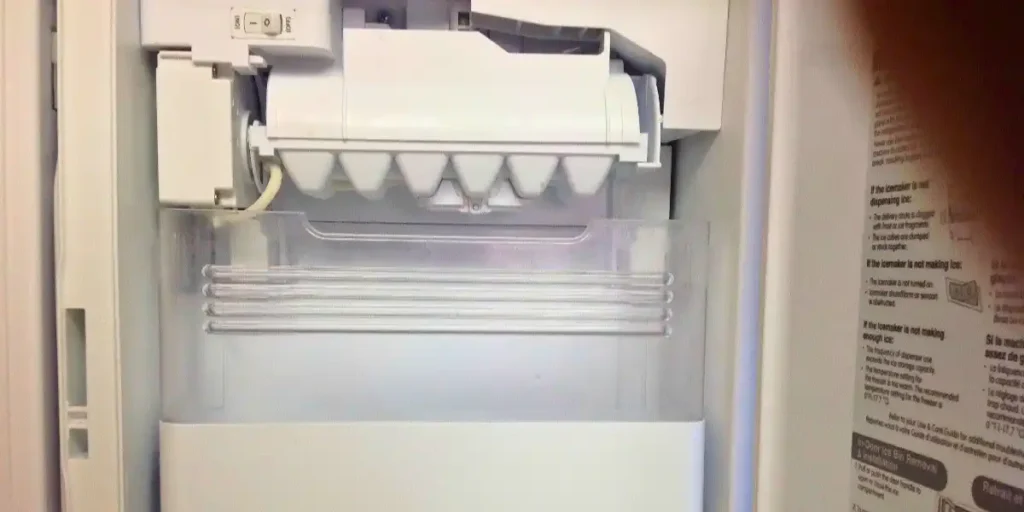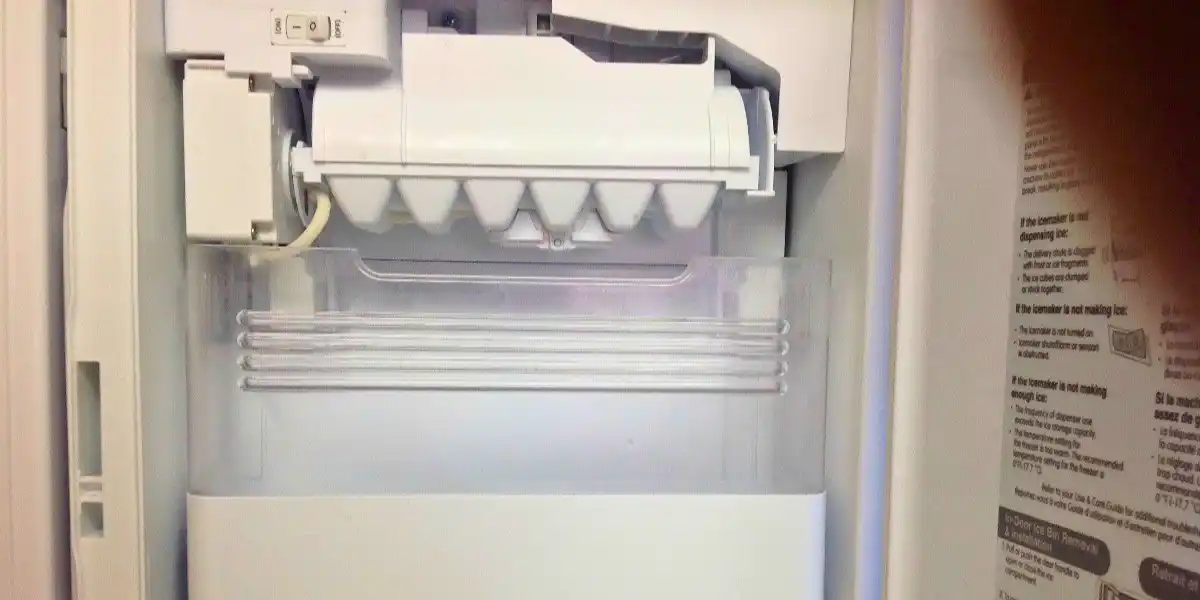
Is your GE refrigerator causing a watery mess around the ice dispenser?
Say goodbye to those leaks and hello to hassle-free ice and water dispensing!
In this article, we’re diving deep into the reasons behind this frustrating issue and providing you with comprehensive solutions.
Get ready to uncover the culprits and learn how to bid adieu to those unwanted puddles.
Why Is My GE Refrigerator Leaking Water from Ice Dispenser?
Loose or Damaged Water Line Fittings
The water line that connects your GE refrigerator to the water supply might have issues with its fittings.
If these fittings become loose, water can seep through the gaps. If they are damaged, the water line may not properly seal, and water can leak out.
Leaks from these fittings often drip down the back of the refrigerator and can be found on the floor.
Normal wear and tear might cause the fittings to loosen over time. Improper installation might lead to damage from the start.
Accidental bumps or knocks can cause sudden damage. Any of these can lead to water leaking from the ice dispenser.
Cracked Water Reservoir or Supply Line
A less common but equally troublesome reason for water leakage is a cracked water reservoir or supply line.
The water reservoir stores the water needed for ice making and dispensing, and any crack in it can lead to leaks.
Similarly, a crack in the supply line that feeds water to the dispenser can result in water seeping out and causing a mess.
The impact of this issue can be particularly frustrating, as the leaks might not be immediately visible, causing water to accumulate unnoticed, potentially leading to water damage.
Clogged Defrost Drain
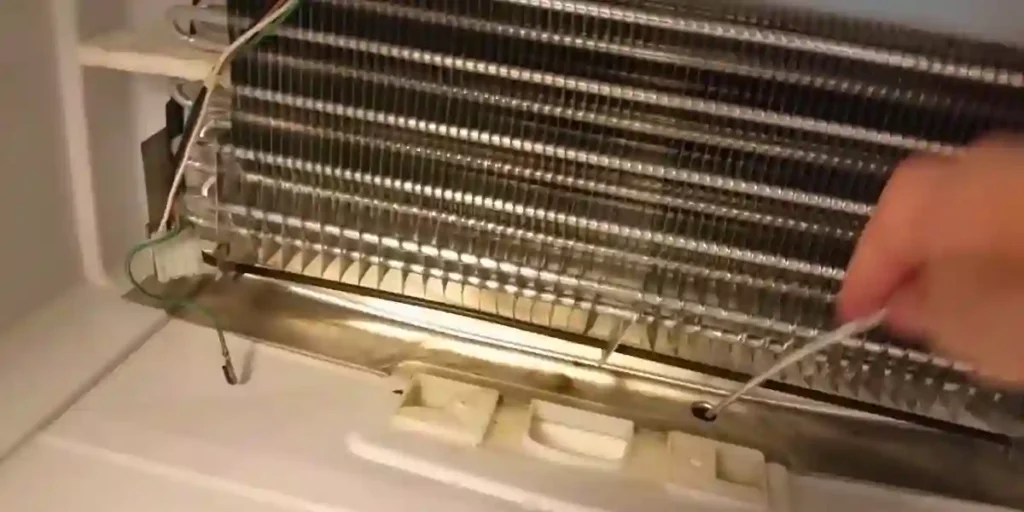
Another potential culprit for water leakage is a clogged defrost drain. Over time, the defrost drain in your refrigerator’s freezer compartment can become clogged with debris, ice, or food particles.
When this happens, water from the defrost cycle can’t properly drain away, causing it to overflow and find its way to the ice dispenser area.
The result? Water leakage that seems to originate from the ice dispenser. If left unaddressed, this issue could not only cause leaks but also impact the cooling efficiency of your refrigerator.
Faulty Water Inlet Valve
The water inlet valve is responsible for controlling the flow of water into the refrigerator’s water and ice dispenser system.
If this valve becomes faulty or starts malfunctioning, it can lead to irregular water flow and leaks.
A valve that doesn’t fully close after dispensing water can cause continuous dripping and pooling, resulting in water leakage around the dispenser area.
This problem might also impact the quality of your ice and water, making it crucial to address promptly.
Improperly Sealed Ice Chute
In some cases, the ice chute that leads from the ice maker to the dispenser might not be properly sealed.
This can allow warm air from the surrounding environment to enter, causing frost and ice buildup inside the chute.
As this ice melts, it can result in water leakage from the dispenser. This issue might not be immediately obvious, but if you notice frost or excess moisture around the ice chute, it’s a sign that this could be the source of the problem.
Excessive Freezer Temperature
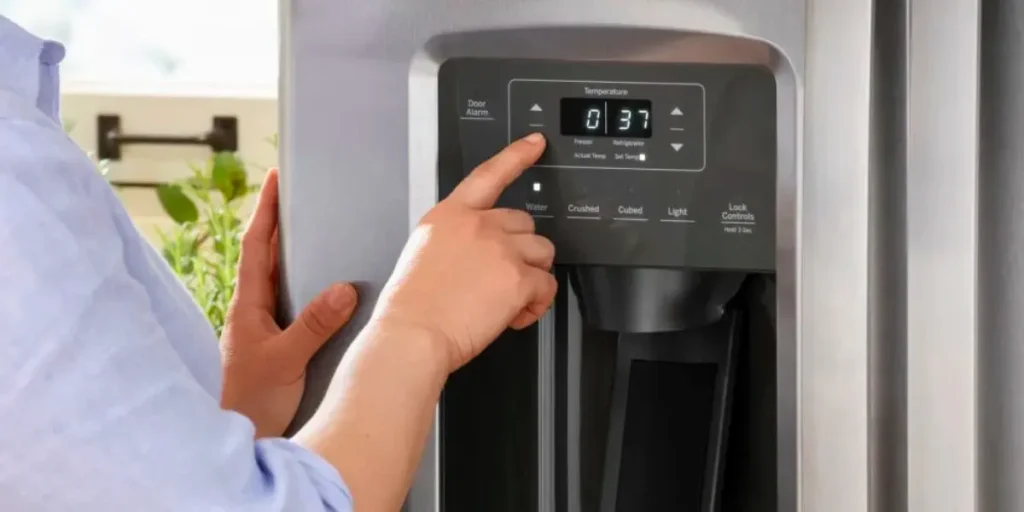
Believe it or not, the temperature of your freezer can also play a role in water leakage from the ice dispenser.
If the freezer temperature is set too low, it can lead to excessive frost and ice accumulation within the ice maker and dispenser mechanisms.
As this ice melts, it can cause water to leak out from the dispenser. Ensuring that your freezer maintains the appropriate temperature is essential to prevent this issue.
Damaged Ice Maker Assembly
A damaged ice maker assembly can also contribute to water leakage. If components within the ice maker, such as the water inlet valve, the ice mold, or the water line, are cracked, loose, or malfunctioning, they can lead to water leaks.
These leaks might occur during the ice-making process or when the ice is dispensed. A thorough inspection of the ice maker assembly’s individual parts can help identify and resolve this issue.
Incorrect Ice Maker Installation
If your ice maker assembly was not installed correctly, it could be a major factor behind the water leakage.
Misaligned parts, improper connections, or poor installation can lead to water escaping from the ice dispenser area.
Even a small gap can result in significant leaks over time. Ensuring that all components are securely and accurately installed can make a significant difference in preventing this issue.
Cracked Ice Chute or Dispenser Housing
Similar to the water reservoir and supply line, the ice chute and dispenser housing are susceptible to cracks or damage.
If the ice chute or housing develops cracks, they can allow water to escape when the ice melts.
These cracks might not be immediately apparent, but they can lead to gradual water leakage that’s hard to trace.
Regular inspection of these components can help catch and address this issue.
Faulty Dispenser Solenoid
The dispenser solenoid is responsible for controlling the opening and closing of the ice chute.
If this component becomes faulty or stuck, it can result in an improperly closed chute, causing water to leak out.
Sometimes, the solenoid might not fully close even after ice dispensing, leading to dripping and subsequent leakage.
Checking the functionality of the dispenser solenoid can help you identify and address this problem.
Incorrect Water Pressure
The water pressure feeding into your refrigerator can impact its functionality, including water and ice dispensing.
If the water pressure is too high, it can result in excessive water flow that overwhelms the system, leading to leaks.
Conversely, low water pressure might cause the water inlet valve to remain partially open, resulting in drips and leakage.
Adjusting the water pressure to the recommended level can help prevent these issues.
Cracked or Loose Reservoir Cap
The reservoir cap is an essential component of the water and ice dispensing system. If the cap is cracked, damaged, or not properly sealed, it can lead to water leakage.
The cap ensures that water is properly contained within the reservoir and doesn’t escape prematurely.
Any issue with the cap’s integrity can cause leaks, even if the rest of the system is functioning correctly.
Regularly inspecting and maintaining the reservoir cap can prevent this problem.
What Are Some Tips to Troubleshoot a Refrigerator Water Dispenser That Is Not Working?
If your Kenmore Elite refrigerator water dispenser is not working, here are some troubleshooting tips. First, check the water supply by ensuring the water line is properly connected. Next, inspect the water filter and replace it if needed. Additionally, verify that the dispenser control panel is set to dispense water. Finally, ensure there are no blockages in the dispenser nozzle. By following these kenmore elite refrigerator troubleshooting tips, you can potentially resolve the issue and enjoy a properly functioning water dispenser.
Troubleshooting Water Leakage From Your GE Refrigerator’s Ice Dispenser
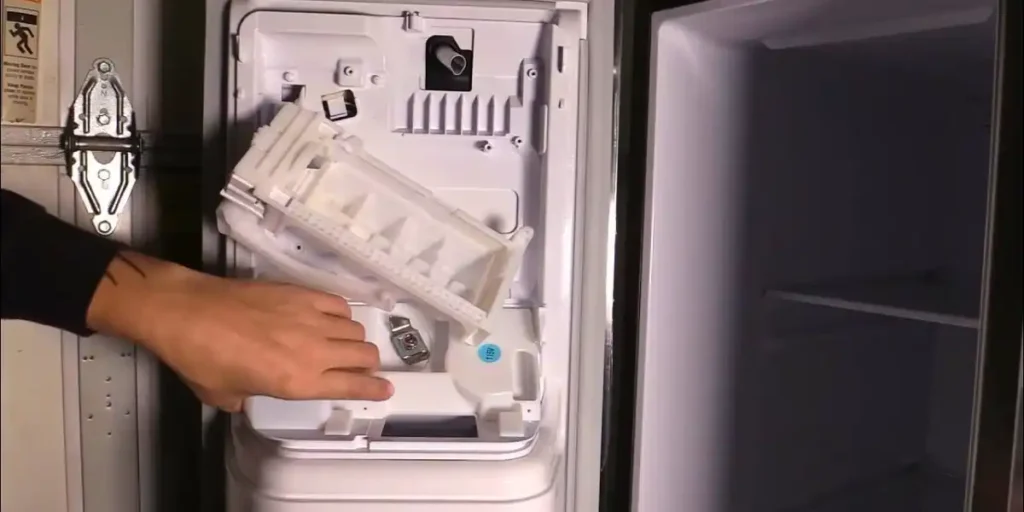
Tighten or Replace the Water Line Fittings
If the water line fittings are loose or damaged, you can fix the problem. First, locate the fittings on the back of the refrigerator.
Use a wrench to tighten them until they feel snug. Be careful not to over-tighten, as that can cause more damage.
If tightening doesn’t work, you might need to replace the fittings. Look for parts that match your GE refrigerator model.
Follow the instructions in your owner’s manual. After you fix the fittings, check for leaks to make sure the problem is solved.
Replace the Cracked Water Reservoir or Supply Line
If you discover a cracked water reservoir or supply line, replacement is the solution. Contact GE customer support or refer to your refrigerator’s documentation to find the appropriate replacement parts.
Follow the manufacturer’s guidelines to carefully install the new reservoir or supply line.
This action will not only resolve the leaks but also prevent further water damage and potential mold growth.
Clear the Clogged Defrost Drain
To address a clogged defrost drain, you need to clear the blockage. Unplug the refrigerator for safety, then locate the defrost drain, typically at the back of the freezer compartment.
Remove debris, ice, or food particles obstructing the drain’s function. Warm water or a pipe cleaner can help dislodge stubborn clogs.
Once the drain is clear, plug the refrigerator back in and monitor for future leaks.
Replace the Faulty Water Inlet Valve
For a faulty water inlet valve, replacement is the solution. Turn off the water supply to the refrigerator, then access the valve, usually behind the refrigerator or at the base.
Carefully disconnect the water supply line and electrical connections from the old valve. Install the new valve, reconnect the water supply line and electrical connections, and then turn the water supply back on.
This solution will stop leaks and ensure consistent water and ice dispensing.
Seal or Replace the Ice Chute
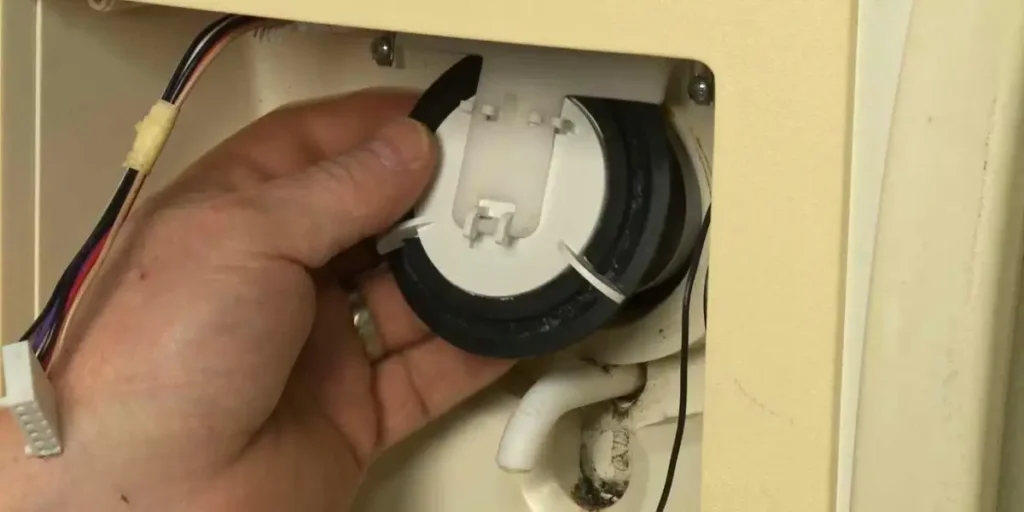
If an improperly sealed ice chute is causing leaks, you have a few options. First, try sealing any gaps or openings around the chute with appropriate materials, such as food-safe silicone.
This might involve disassembling parts of the dispenser mechanism, so refer to your refrigerator’s manual for guidance.
If sealing doesn’t work or the chute is severely damaged, consider replacing it. This solution will prevent warm air from entering and causing moisture buildup.
Adjust Freezer Temperature
To address the issue of excessive ice accumulation, adjust your freezer’s temperature to the recommended setting, usually around 0 degrees Fahrenheit (-18 degrees Celsius).
Use the temperature controls on your refrigerator to make the necessary adjustments. This action will help prevent excessive ice buildup and subsequent water leakage from the ice dispenser.
Replace Damaged Ice Maker Assembly Components
For a damaged ice maker assembly, inspect each component for cracks, damage, or malfunction. Replace any individual parts that are contributing to the leaks. This might involve replacing the water inlet valve, the ice mold, or the water line. Ensuring that all parts are functioning correctly is essential for preventing water leakage.
Reinstall the Ice Maker Assembly Properly
If your ice maker assembly was not installed correctly, it’s crucial to reinstall it properly. Ensure that all parts are aligned, connected securely, and properly sealed to prevent water from escaping.
Taking the time to follow installation guidelines and double-check the assembly can make a significant difference in preventing leaks.
Repair or Replace Cracked Ice Chute or Dispenser Housing
If the ice chute or dispenser housing is cracked or damaged, consider repairing or replacing the affected components.
Sealing cracks or installing a new chute or housing can effectively stop water leaks. Regularly inspecting these parts for signs of damage can help you catch and address issues before they lead to significant leaks.
Replace Faulty Dispenser Solenoid
If the dispenser solenoid is malfunctioning, replacement is the solution. A faulty solenoid can lead to improper chute closure and subsequent water leakage.
Follow the manufacturer’s guidelines to replace the solenoid, ensuring proper closure of the ice chute and preventing leaks.
Adjust Water Pressure
If incorrect water pressure is causing leaks, adjusting the water pressure to the recommended level can resolve the issue.
Consult your refrigerator’s documentation to find the recommended water pressure range.
Use the water supply valve to make necessary adjustments, ensuring that water flow is steady and controlled.
Replace Cracked or Loose Reservoir Cap
If the reservoir cap is cracked, damaged, or not properly sealed, replace it. A secure reservoir cap is essential to prevent water from escaping prematurely and causing leaks.
Regularly inspect and maintain the cap to ensure its integrity and prevent leaks.
Preventive Maintenance tips to avoid Water Leakage
If you want to prevent water leakage in the ice dispenser you need to do some maintenance steps. Let’s know the maintenance tricks to prevent water leaks.
Ensuring a Solid Connection
When it comes to preventive maintenance for your GE refrigerator start by examining the water supply line.
Confirm that it’s securely connected to both the refrigerator and the water source.
Any loose or damaged connections can lead to leaks. Carefully trace the line and use your hands to gently tighten any fittings. This small action can save you from major headaches down the road.
Regularly Replace the Water Filter
Maintaining a clean and efficient water filter is crucial. It prevents water leakage from the ice dispenser.
Over time, a clogged or worn-out filter can disrupt the flow of water. That causes pressure imbalances and results in leaks.
Consult your refrigerator’s manual to find out how often the filter should be replaced.
By staying on this simple maintenance task, you ensure clean and refreshing water. Also, it keeps potential leaks at bay.
A Close Eye for Leaks
Delving into the heart of your ice dispenser system. Take a moment to inspect the ice maker and dispenser components.
Look for signs of wear, misalignment, or ice buildup. A malfunctioning ice maker can lead to excess water accumulation. Resulting in leaks.
If you notice any issues, follow the manufacturer’s guidelines to address them promptly. Regular visual checks can help you catch and address potential problems before they escalate.
Preventing Overflow Mishaps
Often overlooked, the drain pan and evaporator coils play a significant role in preventing water leakage. The drain pan collects excess water during the defrost cycle.
If it’s clogged or full, water can overflow and cause leaks. Similarly, dirty evaporator coils can lead to ice buildup.
That affects the overall function of your refrigerator. Take the time to clear the drain pan and clean the coils periodically. It maintains proper drainage and prevents leaks.
Finding the Sweet Spot
The temperature settings of your refrigerator and freezer can impact the overall performance of your ice dispenser.
Extreme temperature fluctuations can cause ice to melt. That results in water leakage.
Ensure that your refrigerator and freezer are set to the recommended temperatures. It maintains a stable environment. Regularly monitoring and adjusting these settings can contribute to leak prevention and the longevity of your appliance.
Expert Insight and Care
While there are steps you can take on your own, professional maintenance is a valuable investment. Regular check-ups by a trained technician can identify potential issues before they become major problems.
A technician can also ensure that all components are functioning optimally. It reduces the risk of leaks. Don’t hesitate to reach out to the professionals. It helps to keep your refrigerator in top-notch condition.
By implementing these preventive maintenance tips you’re actively safeguarding the GE refrigerator’s ice dispenser. Regular maintenance can ensure a leak-free appliance.
That provides you with refreshing ice and water without the unexpected mess. Remember, a little proactive care goes a long way in ensuring efficiency and longevity.
FAQs
Can the leak be due to a clogged filter?
Yes, a clogged water filter can affect water flow. That potentially leads to leaks. Regularly replacing the water filter can prevent this issue.
Should I call a professional for help?
If you’re unsure about troubleshooting or if the issue persists, it’s a good idea to contact a professional repairer.
Is there a specific tool I need for troubleshooting?
You may need basic tools like a wrench, screwdriver, and a flashlight for a thorough inspection and potential fixes.
Can I use the refrigerator while troubleshooting?
It’s best to avoid using the ice dispenser while troubleshooting. It prevents further leakage and potential hazards.
Could high water pressure be causing the leak?
Yes, excessive water pressure can strain components and cause leaks. Consider installing a pressure regulator if you suspect this is the issue.
Conclusion
A GE refrigerator leaking water from ice dispenser can be a real headache. But armed with the knowledge from this guide, you can easily tackle the issue.
Follow the step-by-step troubleshooting guide to regain control over your refrigerator. Enjoy ice-cold water without the unexpected puddles.
Remember, a little maintenance and attention go a long way in keeping your appliances running smoothly. So give some time for maintenance.

